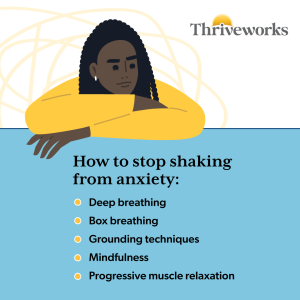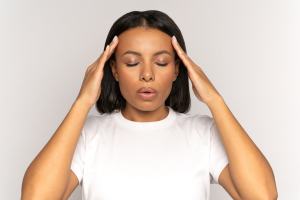Anxiety can become overwhelming, especially when its symptoms impact your day-to-day life. Shaking, racing pulse, sweating, and more can overtake someone when their anxiety is heightened, which can make it difficult to be around certain stimuli—even everyday situations.
However, there are simple ways to help lower anxiety and thereby lessen symptoms like shaking. Techniques like deep breathing and mindfulness can be extremely helpful in reducing shaking and other symptoms caused by anxiety.
Understanding Anxiety-Induced Shaking
Anxiety-induced shaking happens when intense anxious feelings cause someone to start shaking or trembling. This response is usually caused by the activation of the “fight or flight” response, which triggers a surge of adrenaline that causes the shaking to occur.
Anxiety-induced shaking isn’t a dysfunction; rather, an indication of your body’s primal response to interpreting a threat and preparing itself to respond. Though in dangerous situations it is meant to be a lifesaving response, when someone’s anxiety is too intense or caused by mundane situations or events, this shaking can impede a person’s daily functioning.
What Causes Anxiety-Induced Shaking?
Anxiety is likely to occur when catastrophizing (assuming the worst is going to occur) is coupled with underestimating your ability to cope or deal with a situation. In extreme cases, such as life-threatening situations, anxiety can cause the body to shake uncontrollably. However, sometimes our minds react with disproportionate anxiety, in situations that are not life-threatening or dangerous, due to conditions like trauma or anxiety disorders.
While anxiety-induced trembling and shaking can be annoying and distracting, it is a physiologically normal response. To determine the cause of anxiety-induced shaking, it’s helpful to identify the source of the anxious response. By assessing the cause and getting treatment, you can start to ensure that the anxiety you feel is not constantly overwhelming you or making it difficult for you to function.
Immediate Relief Techniques for Anxiety Shakes
Physical activity, such as brisk walks or jogging, and relaxation techniques are likely to help with immediate relief from “anxiety shakes.”
Relaxation techniques are strategies that promote a calm body and mind. As this kind of shaking is a physical manifestation of anxiety, it can be most effective to use relaxation techniques that concentrate on the body. This can include:
- Progressive muscle relaxation: This is a technique where the individual consciously isolates different muscle groups one at a time and increases their tension for about 5 seconds, followed by a sudden release. By isolating each group, they can more effectively relax each muscle, helping to release tension.
- Body scan: This refers to a meditation technique where an individual mindfully goes through each part of their body in order to notice any areas of tension, pain, or discomfort.
- Yoga: Yoga focuses on regulating breathing and learning to position one’s body in ways that release tension, redirect energy, improve self-control, and maintain overall relaxation.
Hello, we're here to help you
We provide award-winning mental health services nationwide, with flexible scheduling & insurance coverage. Start your journey this week.
Breathing Exercises for Instant Calm
By practicing breathing exercises, you can regulate the pattern of your breathing to decrease your heart rate and improve brain function through bouts of anxiety. Below are some examples of breathing exercises that will help promote calm
- Diaphragmatic breathing: This technique is also called “deep breathing,” “belly breathing,” or “abdominal breathing.” Diaphragmatic breathing involves contracting your diaphragm while inhaling in order to increase your oxygen intake. To practice, lie down on a flat surface, with your head supported and knees bent. Put one hand on your upper chest just below your neck and the other on your belly. Breathe in through your nose, feeling your chest and belly rise, and exhale for a of couple seconds longer than it took to inhale. Repeat until you feel a sense of calm.
- Box breathing: Also known as “four-square breathing,” box breathing is a simple breathing technique that helps with calming oneself during a fight or flight response. To practice, inhale for a count of four, hold your breath for four seconds, exhale for a count of four, and hold your breath once more for four seconds. Repeat.
- 4-7-8 breathing: This pranayama (yoga breath-control practice) breathing technique is credited to medical doctor, Dr. Andrew Weil who once described it as a “natural tranquilizer for the nervous system.” To practice, sit quietly in a comfortable location free of distractions. Lightly place your tongue on the back of your teeth and breathe out, allowing your lungs to empty. Through your nose, inhale for a count of 4. Hold your breath for 7 seconds, then exhale for a count of 8 seconds. Repeat four times.
- Laughter: The expression of amusement, derisiveness, or joy actually causes a rapid succession of inhalation and exhalation. Laughing promotes longer exhalation, which promotes cleaner ventilation by exhausting residual air and supplying the body with healthy doses of oxygen.
Once you find a breathing exercise that works for you, you’ll be able to reliably calm yourself when you need to, which will help you function regularly—especially if you struggle with anxiety. If your anxiety becomes too difficult for you to handle on your own, consider talking to a mental health professional about your symptoms. They can help you assess the root of the issue and give you personalized tools to help you manage it.

Mindfulness and Anxiety Shakes: How Mindfulness Can Help
Mindfulness exercises can help prevent shaking due to anxiety, as well as manage anxiety symptoms. Mindfulness is the practice of being aware of your internal state and your external environment. This is achieved by learning to observe without reacting or judging what you think or feel.
A 2014 study explored the usefulness of meditation programs and found that mindfulness meditation programs could improve anxiety symptoms over the course of 8 weeks.
Mindfulness is less about coping with anxiety and more about accepting your thoughts as they are and being curious about the thoughts or feelings that arise within you. Mindfulness helps with mental flexibility and helps promote feelings of control, which can increase resilience. When you become aware that you have the ability to choose what you focus on or how you think about something, it creates opportunities to choose a more positive perspective, like compassion or gratitude.
Long-Term Strategies for Anxiety Management
To decrease anxiety long-term, it helps to identify the source of the anxiety. However, if you find that doing this on your own is difficult, consider talking to a mental health professional about your anxiety. A licensed mental health provider can help you work through the root cause of your symptoms and give you helpful tools to help you manage them on your own, such as biofeedback training, relaxation techniques, and medication.
Biofeedback refers to a therapist-led process in which the client analyzes and interprets their body’s responses to stimuli. This would allow you to manage your internal environment better and make modifications as needed.
Relaxation techniques are therapeutic processes intended to stop the increase of tension and promote a calm mind and body. These processes often incorporate diaphragmatic breathing, commonly known as deep breathing, which is helpful for managing anxiety. It slows down the heart rate, relaxes muscles in the gastrointestinal tract, slows down racing thoughts, decreases the likelihood of triggering the “fight or flight” reaction, and overall calms the nervous system.
Finally, medication can sometimes be the best route for calming intense anxiety symptoms. Though oftentimes they are not a permanent solution, they can help decrease the intensity of symptoms, allowing you to function more easily and giving you the emotional energy necessary to sort through your triggers and symptoms in talk therapy.
Whichever strategy works for you, finding ways to manage your anxiety is an important step in overcoming the symptoms holding you back. With the right tools, you can learn to understand and function alongside your anxiety, allowing you to live the life you want.













